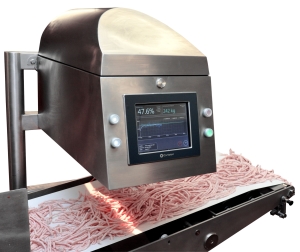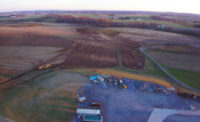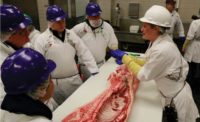 TOMRA Sorting Solutions continues to expand its presence in the meat industry, delivering a range of machines, from analytical to sorting solutions, for different types of product.
TOMRA Sorting Solutions continues to expand its presence in the meat industry, delivering a range of machines, from analytical to sorting solutions, for different types of product.
Demand for the company’s established QVision fat analyzer continues to grow, with a multitude of new orders from Europe and North America. The QVision system, launched three years ago, allows meat processors to secure the maximum benefits available from in-line fat analysis and real time process control. Many of the initial users have placed repeat orders, proving the effectiveness of the system for their operations. QVision continues its success with large meat processors, with VION adding their first in-line analyzer in its facility in Bad Bramstedt, Germany.
Matthias Gessner, market unit manager, meat, TOMRA Sorting Solutions, said, “Even with carcass classification, cutting patterns and employees possessing decades of experience, large variations in the fat levels of input meat are inevitable. But now, with years of research and proving in the field, the QVision In-line analyzer measures fat, protein, collagen, moisture and weight in fresh or frozen meat, at any grind size, across the full width of its conveyor belt, with analysis penetrating far into the meat.
“The QVision’s unique analysis technology, penetrating up 25mm into the meat, delivers the highest accuracy and allows the measurement of the entire product on the conveyor. On blended meat productions, it allows immediate process control, removing the need for sample and correction time. To high volume manufacturers, this results in increased output, which can be supported by the QVision with its capacity to analyze 30 tons per hour.
“In addition to capacity increase and the reduction of lean giveaway, the QVision helps customers to get better yield from their raw materials, while ensuring consistent product quality. This eliminates the risk of ‘out of spec’ fat claims.”
The EU put into force a regulation (EC) 1169/2011 in January 2014 stating that, in addition to the fat content, the collagen/meat protein ratio must be displayed on all consumer packaging for minced meat products. In response to this, TOMRA has released a new software version for the QVision analyzer. This allows the measurement and recording of collagen, protein and the respective ratio, ensuring producers are compliant with current legislation.
Since its introduction to the market, TOMRA says the QVision has proven to be an effective and popular solution for meat processors. The system reaffirms the company’s position as a leading provider of cutting-edge technology and expertise within the meat industry.
Sorting Solutions
Alongside satisfying analytical requirements, TOMRA is now developing sorting solutions for meat applications, two of them applying to bacon bits, beef jerky, IQF meat and dried sausages.
Gessner said, “The two processes use different platforms, which shows the sheer variety of these and the technologies available. This wide range allows a processor to combine virtually every technology and any platform, to provide a customized solution for their particular sorting challenge.”
Bacon bits, used in salads and other dishes or as food toppings by consumers, can be sorted on a TOMRA Nimbus free-fall laser sorter. The company says that through listening to its customers and constantly investing in R&D, it has developed a special version of the Nimbus for meat, with its mechanical design adapted to reflect the differences in material handling.
The bacon bits, or e.g. beef jerky or IQF meat are scanned by lasers from two sides, which detect black, burned pieces, off-spec products and foreign material, that are rejected milliseconds later by air valves. The machine uses a feed shaker, over which the product is spread uniformly, so a single layer progresses onto the free-fall chute. It then falls towards the inspection zone, and is spread out by gravitation, where it is scanned by the lasers.
A few milliseconds later, defective pieces are hit with a precise and powerful burst of air, which sends them into the rejection zone, while the good product continues its natural free-fall.
In addition to sorting by discoloration, the machine can detect and remove different types of foreign material, including bones, plastics (in colors such as yellow, blue and green), wood, aluminum, paper, and metal pieces. The machine can be set in different ways, for precise sorting.
Gessner said, “The equipment is extremely user-friendly and no engineer is needed to alter the computer programs. Even people without technical backgrounds can adjust the settings easily, as long as they have reasonable product knowledge.”
TOMRA’s changes include to the Nimbus’s electronic and optical components, to make it tailored for optimal detection in meat applications.
Gessner said, “Probably the most important adaptation is to the design, to make it easy for cleaning and ensure it has no hidden parts where meat could stick.
“Features of the special Nimbus include open frame design, a special mount for optics, to prevent bacteria growth in the frame, and sloped surfaces, avoiding product lying on the frame. We’ve also removed all unnecessary holes in the frame, ensured all parts on the sorter are mounted with spacers for better cleaning, and that hygienic, adjustable feet are fitted to the machine frame and shaker frame with hidden threads.”
Sausages can be sorted on a TOMRA Genius belt sorter with camera detection. The product is spread uniformly on a belt, using an in-feed shaker, and transported to the inspection zone, where it is scrutinized by cameras.
The sausages are sorted based on length, with different sizes within grade being passed and any off-spec products being rejected and potentially used for other purposes. Sausages can also be sorted by shape. TOMRA says it has achieved particularly impressive results in sorting small dry sausages, as well as sticks.
For more information visit www.tomra.com/food.





Report Abusive Comment